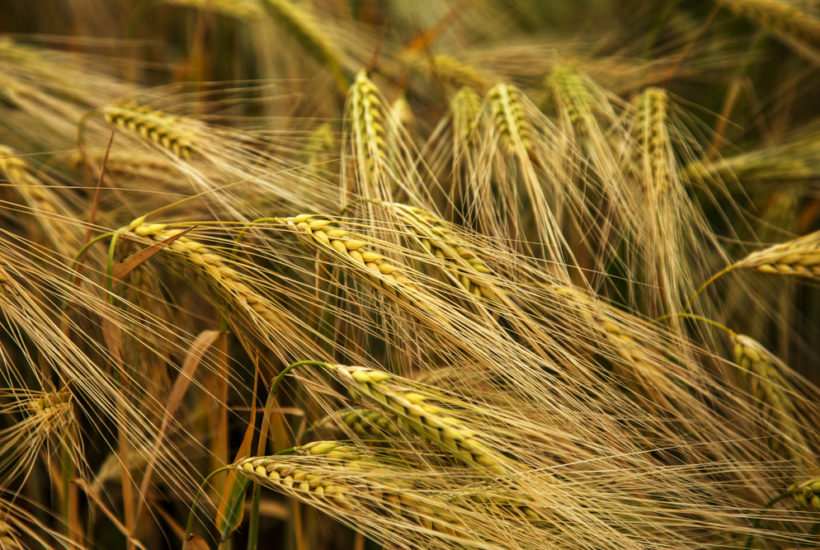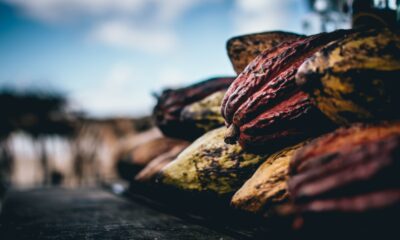Featured
Wheat markets move higher amid potential disease problems
Meanwhile, corn exploded higher last week as the weather market got underway.

Wheat
Wheat markets were higher last week as traders started to hear about disease potential in winter wheat crops. Minneapolis spring wheat markets were also higher but rallied less than the markets in Chicago due to ideas of better planting conditions for crops in the northern Great Plains and Canadian Prairies. There has been some talk of disease problems for the winter wheat crops. Ideas are that the current wet and cool weather is the perfect breeding ground for scab and other diseases that can rob yield potential. There have been no confirmed reports of disease in the crops yet, but the weather has been good for promoting the disease. The areas most favored for the disease are the Midwest and eastern Great Plains. The crop most affected would be the Soft Red winter crop. Current weather forecasts call for warmer temperatures this week and more wet weather.
Demand has been the big problem for any bullish traders for the last year and demand has been better for the last few weeks. The demand is the past year has been disappointing as weaker prices have not improved sales. World prices have been stronger than those in the US due to less production in major world exporters such as Russia, Europe, and Australia. The outlook is for improved production this year from competing producers so the chances for the US to sell a lot more Wheat into the world markets are fading. The daily and weekly charts show that the Chicago markets are near some resistance areas and could find increased selling pressure this week on further rallies. Minneapolis is also getting closer to some resistance areas on the charts.
Corn
Corn exploded higher last week as the weather market got underway. It was a very impressive rally that was caused by another week of cold and wet weather. It has been too cold and wet for most producers to consider planting. Many have not even been able to do initial fieldwork to prepare the soils for planting, and soils in many cases are too cold for seeds to germinate properly. The planting pace is thought to be one of the slowest in history, or at least over the last 30 years or more. Ideas are that USDA will show that half or less of the crop has been planted when it releases its weekly updates on Monday afternoon. The slow planting progress means that lower yields are a certainty and there are increasing ideas that not all of the intended area will get planted.
USDA will need to reduce production estimates at some point this Summer, although that might not happen for a couple of months. Reduced production and static demand will lead to lower ending stocks for the US, and that implies higher prices at some point down the road. The magnitude of the rally will depend partly on [production, but also on demand, and demand has been less than stellar. There is a good crop coming in Brazil and Argentina, so the US will have competition for sales. Prices will rally, anyway, but it will take a real disaster to see prices go very much higher. The chart shows that the trends are changed and that higher prices are possible. Prices basis the nearby futures over $4.00 per bushel to perhaps $4.25 per bushel in the short term are possible now. The funds remain very short in the futures market, and forcing them out of these positions could push prices higher than might otherwise be expected.
Soybeans and soybean meal
Soybeans and soybean meal were higher last week, mostly in sympathy with the rallies in the grains markets. Soybeans trends are still down as the market has seen some extreme selling and very little buying interest in the last few weeks. The weekly charts for soybeans still show the potential for futures to move to about 770 bases the nearest futures contract. Soybean meal trends are also mostly down. The market is waiting for the trade deal with China but worried about overall Chinese soybeans demand due to the Asian Swine Flu that has decimated the hog herd there. The government reports that at least 20 percent of its hog herd has been lost and private estimates show much higher loss potential.
In addition, hopes for a trade deal in the near term faded last week as the Trump administration accused China of trying to cancel already agreed terms and imposed new sanctions. Trump moved against Huawei on Friday by banning the use of its components in telecommunications equipment that might be used in the US or in business trying to work in the US. China responded by saying further negotiations need not happen until the US shows some sincerity in coming to a deal.
A new trade deal with China might now have to wait until the presidential elections in 2020 are over. That is very bad news for US soybeans producers and good news for producers in other countries around the world. It means that any rallies tied to bad weather or any other reason might not go very far as supplies in the US are big now and demand is not likely to improve very much anytime soon.
Rice
Rice was higher once again last week and closed just off the highs for the week. The market added to gains on Friday after trading in consolidation for a few days. Futures are breaking through some resistance areas on the weekly charts and the charts now show the chance for prices to move significantly higher. Ideas for planting delays in rice and continued good export demand have been reasons to support futures. Growing areas near the Gulf Coast and in Texas are mostly planted now, and crop development has been reported to be uneven. Some areas look very good while others have struggled to get good stands due to excessive rains.
Planting progress remains more sporadic to the north due to cool and wet conditions, but some planting is getting done. There are some areas that might not get planted this year as producers are starting to run out of time to get the crops in and up and then to expect good yields. The funds and other speculators have been buying to cover some huge short positions. The domestic market is using price breaks to extend forward coverage as the mills push to own rice into the next harvest. Prices have been firm in Texas due to good demand for limited supplies. Much of the rice is moving to Mexico. Prices have been firm in Arkansas due to a lack of producer selling as they wait to get the next crop planted. Current supplies are high and bearish traders point to this fact as a reason to keep prices relatively cheap, but they appear to be losing the battle at this time.
Palm oil and vegetable oils
World vegetable oils markets closed higher last week as demand ideas started to improve. Palm oil was the primary beneficiary of the buying on ideas that China could cut purchases of soybeans in the world market due to the Asian Swine Flu epidemic in the country that is killing off a large part of the hog herd. They will be producing less soybean oil and could increase purchases of palm oil to compensate. They would most likely purchase Soybean Oil from Argentina as well but will avoid buying in the US if at all possible. Canola was firm again last week after holding contract lows as supplies in the country remain high and demand has softened.
The court case in which a Chinese national could be deported to the US on industrial espionage charges remains a major issue between Canada and China, and China has basically cut off purchases of Canadian canola due to the trial. Canada is appealing to the US to help it solve the issue since the arrest was made at the request of the US government. However, trade negotiations between the US and China have blown up in the last couple of weeks. There’s probably little the US can do even if it wanted to. The US is taking further action to ban the use of Huawei equipment and parts in the US on industrial espionage charges so relations are bad again.
The market has tried to become more stable in recent weeks but faces strong headwinds in getting demand flowing again and avoiding big ending stocks. Worries that low production and low planted area this growing season have started to support new crop prices. Soybean oil was higher in sympathy with the rallies in other world vegetable oils markets. US soybean oil faces increased competition in world markets from Argentina as its soybeans are harvested and processed. Argentina will look to reclaim its position as the largest exporter of soybean oil in the world.
Cotton
Cotton was sharply lower for the second week in a row as the lack of progress in the trade negotiations with China created a double slam for this market. Also pressuring the market are forecasts for big production here and around the world. USDA sees no shortage of cotton anywhere in the coming year. Trends are down on the daily and weekly charts. The lack of a deal with China means less potential to sell US cotton there. China has bought in limited amounts from the US this year as it seeks to cover a short crop of its own. However, it has bought more from India and now can look to Brazil for supplies.
The breakdown in trade negotiations between the US and China means that the US will likely have sold what it will sell to China this year and that China could even cancel some previous purchases. The stock markets worked lower as there were some new fears about the world economic health, and that meant cotton futures had another reason for weaker prices. The weekly export sales report showed stronger demand for US cotton. There are still expectations that the US can have strong sales with other major exporters starting to run low on supplies for the current marketing year, but so far improved demand has done little to support prices.
Frozen concentrated orange juice and citrus
FCOJ was higher, but closed well off the highs for the week as trapped longs and producers used the rally attempt to get some selling done. There was no apparent fundamental reason for the rally, but the charts show that futures had become oversold. Trends are still down on the daily and weekly charts as the market looks at a big oranges crop and weak demand for FCOJ. USDA production estimates are above 70 million boxes. That means that there should be no shortage of oranges available to the market to make FCOJ. Inventories inside the state are significantly higher than a year ago as Florida Citrus Mutual showed a 22 percent increase in state inventories in its weekly report. The increase is coming from less demand and good imports along with the increased domestic production.
The oranges harvest remains active in Florida as the new crop begins to develop. Producers are concentrating on harvesting Valencias and harvest progress should be strong. Fruit for the next crop is developing and are as big as golf balls. Production is very uniform so far this year and development throughout the state is about equal. Some fruit drop is being reported, but this is normal as the trees move to the next crop and drop the old fruit. Irrigation is being used a few times a week to help protect crop condition, but showers are seen several times a week. Mostly good conditions are reported in Brazil as the harvest there gets underway.
Coffee
Futures were a little lower for the week in both markets as much for currency reasons as for anything having to do specifically with coffee. Weakness in the Brazilian Real caused some speculative selling earlier in the week in New York, while reports of steady offers from Asia hurt Robusta in London. Weakness at the end of the week came from strength in the US Dollar. The trade is still worried about big supplies, especially from Brazil and low demand. Brazil is dominating the market, and other exporters are having a lot of trouble finding buyers.
However, buyers are now more actively pursuing other origins, especially for certified or higher end coffees. Roasters were scaling down buyers on the extended down move and now have more than ample supplies in-house or on the way. Prices are generally below to well below the cost of production for world producers, and prices are getting to that point for producers in Brazil and Vietnam. The inventory data from ICO and others shows ample supplies in the world market. Brazil had a big production year for the current crop, but the next crop should be less as it is the off year for production. Ideas are that the next crop might still be big as the weather has been good for the trees so far. Mostly dry conditions are in the forecast for this week.
Sugar
Futures were lower last week. The trade thinks that there is plenty of sugar available to meet any demand. Chart patterns on the weekly charts are sideways to down in New York and sideways to down in London. The fundamentals still suggest big supplies, and the weather in Brazil has improved to support big production ideas. Demand seems to be average and routine. Brazil weather is good in all areas as there is less rain in southern areas and more to the north.
However, UNICA reported a slow start to the harvest season in the center-south area due to a lot of rain. The processing pace remains below the year-ago pace in the latest data. Brazil has been using a larger part of its sugarcane harvest to produce ethanol this year instead of sugar, but Thailand has shown increased production this year. Ideas that production in India and Pakistan is being hurt, but wire services report bumper offers from India and Thailand in the white sugar market. Very good conditions are reported in Thailand, but production this year could be less due to the reduced area and low prices. Demand for sugar has been average, and demand for ethanol is reported to be increasing.
Cocoa
Futures closed higher in New York and lower in London. New York closed near the highs after testing support on the weekly charts. Trends are still up in New York but are down in London. The main crop harvest should be about over and mid-crop harvest is still a month or more away. Ivory Coast arrivals are strong so are the exports. The weekly arrivals pace is about 15 percent higher than a year ago and is holding this level. Arrivals were reported strong in the rest of West Africa as well.
Demand appears strong and the market saw stronger than expected grind data when the quarterly grind is released in the EU, North America, and Asia in the last month. Growing conditions are generally good in West Africa. Periods of showers and cooler temperatures were beneficial, and most in West Africa expect a very good mid-crop harvest. Cameroon and Nigeria are reporting less production and prices there are reported strong. Conditions appear good in East Africa and Asia, but East Africa has been a little dry as has Malaysia.
(Featured image by DepositPhotos)
—
DISCLAIMER: This article expresses my own ideas and opinions. Any information I have shared are from sources that I believe to be reliable and accurate. I did not receive any financial compensation for writing this post, nor do I own any shares in any company I’ve mentioned. I encourage any reader to do their own diligent research first before making any investment decisions.

-

 Biotech1 week ago
Biotech1 week agoSpain Prioritizes Clinical Benefit Over Efficiency in Funding New Cancer Drugs
-

 Africa6 days ago
Africa6 days agoBank Al-Maghrib’s Final 2025 Meeting Expected to Maintain Key Interest Rate
-

 Crowdfunding2 weeks ago
Crowdfunding2 weeks agoOpstart Unifies Crowdlender: A Streamlined, Wallet-Free Investment Hub Launches December 2025
-

 Africa2 days ago
Africa2 days agoMorocco Allocates 1.3 Billion Dirhams to Boost Startup Ecosystem Under Digital 2030 Strategy

























